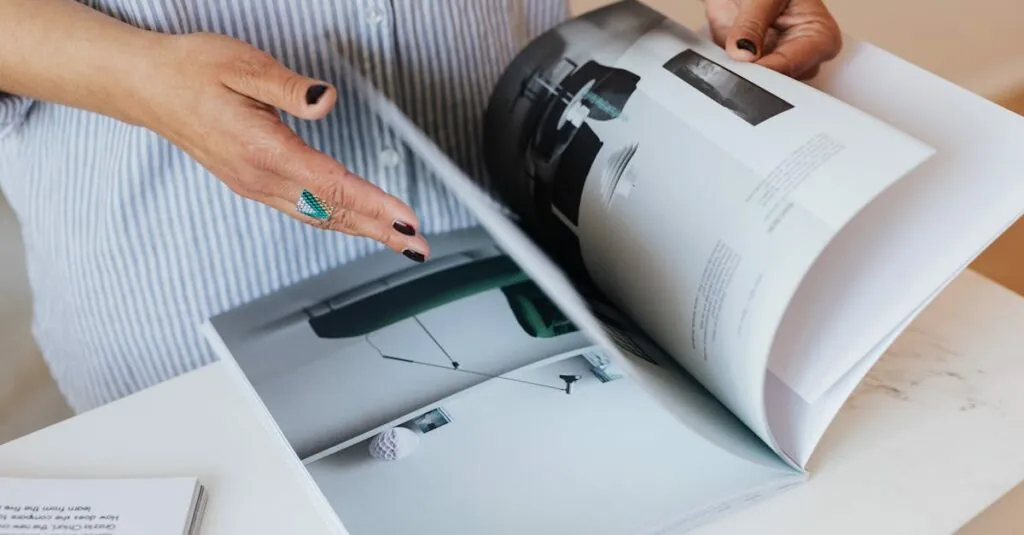Table of Contents
ToggleEver found yourself staring at an image in Google Docs, wishing it could just face the other way? You’re not alone. Whether it’s a sneaky selfie or an infographic that’s just a tad off, flipping images can be a game changer. It’s like giving your visuals a makeover without the hassle of a full photo shoot.
Understanding Image Flipping
Image flipping allows users to create a mirrored version of an image. This technique enhances visual content in Google Docs, providing a fresh perspective on existing images.
What Is Image Flipping?
Image flipping involves creating a horizontal or vertical mirror of an original image. Mirrored images appear as if they are reflected in a mirror, changing their direction while keeping all other attributes intact. Users typically flip images to alter the scene’s perspective or to adjust layouts for better visual harmony.
Why Flip an Image?
Flipping images serves multiple purposes in document design. Improved aesthetics often result from adjustments, enabling enhanced visual appeal and balance. Flipped images can also correct orientation issues in photos or infographics. Particularly in cases of self-portraits, flipping can ensure the image appears more natural. Furthermore, this technique supports better flow in layouts by aligning visual elements cohesively, creating a more professional appearance.
Steps To Flip Image On Google Docs
Flipping an image in Google Docs requires a few straightforward steps, allowing users to enhance their document visuals effectively.
Accessing Google Docs
Open Google Docs by navigating to the official website. Log into your Google account for access to your documents. Locate the document where the image will be modified. Subsequently, make sure the desired document is selected to work on.
Inserting an Image
Insert an image by clicking on the “Insert” menu. Select “Image” to choose from available options. Options include uploading from your computer, selecting from Drive, or using a URL. Ensure the image appears in the document after selection, setting the stage for further adjustments.
Flipping the Image
Click on the inserted image to highlight it. A toolbar appears above the document once the image is selected. Use the “Actions” menu, then choose “Rotate” to access flipping options. Select either “Flip horizontally” or “Flip vertically” based on the desired effect. The image will mirror accordingly, allowing for refined visual presentation.
Final Adjustments
Adjust image size and positioning by clicking and dragging the corners. Resizing ensures proper alignment within the document layout. Utilize the toolbar to modify the image further, including brightness, contrast, or cropping adjustments. Confirm all changes to enhance the overall document appearance effectively.
Tips For Effective Image Flipping
Effective image flipping in Google Docs enhances visual appeal. Consider these tips for improved results.
Maintaining Image Quality
Maintaining image quality is crucial when flipping images. Always choose high-resolution images to prevent pixelation. Enlarging images can distort them, so ensure the dimensions suit your document’s layout. Check image clarity after flipping to confirm it maintains sharpness. Compressed images may lose quality during manipulation; opt for formats like PNG or JPEG for better results. Regularly preview changes to assess quality before finalizing the document.
Using Alternative Methods
Using alternative methods can expand image editing capabilities. Explore Google Drawings, which offers more advanced options for flipping images. Insert images into Google Drawings, select them, and access the “Format” menu for flipping tools. After adjustments, save the image and reinsert it into Google Docs for seamless integration. Third-party image editing tools such as Canva or Pixlr provide additional features, including rotation and resizing, enhancing creativity and flexibility in design.
Common Issues To Watch Out For
Flipping images in Google Docs can lead to specific challenges. Users should be aware of common issues that may arise during the process.
Image Not Flipping Correctly
Images may not flip as expected due to several reasons. The first reason could stem from unsupported file types, which prevent proper modifications. Secondly, images that are grouped might also cause issues; it’s essential to ungroup them before attempting to flip. Incorrectly highlighted images can lead to no changes taking effect as well. Users often overlook that the flip options are only available in the “Actions” menu. Ensuring the image is selected and the correct option is accessed is crucial for a successful flip.
Formatting Problems
Formatting problems often occur after flipping images, affecting overall presentation. Flipped images might disrupt surrounding text alignment or overlap with other elements in the document. Improper sizing can also create an unbalanced design, diminishing visual appeal. Users frequently encounter different results when exporting to various formats. Changes in orientation may not appear in print or when converted to PDF. Maintaining consistent formatting is vital for a professional-looking document. Adjustments may be necessary after flipping to ensure all elements work harmoniously together.
Conclusion
Flipping images in Google Docs is a straightforward yet impactful way to elevate document aesthetics. By mastering this simple technique, users can enhance their visuals and create a more polished presentation. Whether correcting orientation issues or improving layout flow, the benefits of image flipping are clear.
With the right approach and attention to detail, anyone can transform their documents into professional-looking works. Embracing these tips not only simplifies the process but also encourages creativity in design. As users explore additional editing tools, they’ll find even more possibilities to make their images stand out.







